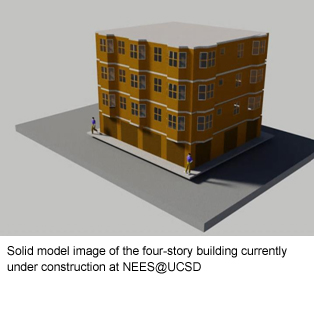Task: Testing of a Full-Scale four-Story Retrofitted and Un-Retrofitted Building at NEES@UCSD
The NEES-Soft Project, whose full title is "Seismic Risk Reduction for Soft-Story Woodframe Buildings" is a five-university multi-industry collaboration has the objectives of developing and demonstrating a methodology to retrofit soft-story woodframe buildings to (1) protect life safety and property by avoiding soft story collapse and excessive upper story accelerations, and (2) provide a mechanism by which soft story woodframe buildings can be retrofitted using performance-based seismic design (PBSD) to achieve a level of performance commensurate with their stakeholders target. This will be accomplished through a comprehensive combination of new numerical modeling procedures, hybrid testing for validation of two levels of soft story woodframe retrofit (i.e. ATC 71.1 and seismic protection systems), and system level validation to better understand the mechanisms of woodframe collapse and the effect of these two levels of retrofit on system performance.
Understanding the collapse mechanisms and how to mitigate the risk imposed by them requires a transformative leap in modeling and analysis of structures, resulting in the ability to accurately predict performance over a wide range of seismic loading conditions. The NEES@UCSD testing is the system-level validation of the performance-based seismic retrofit (PBSR), and experimental validation of the FEMA P807 guidelines for seismic retrofit. Four retrofits will be tested during the five week experimental program: (1) cross laminated timber which aligns with a FEMA P807 application and the San Francisco mandatory soft-story retrofit ordinance utilizing the Simpson Strong Tie hold down/rod system; steel special moment frames designed in collaboration with and supplied by Simpson Strong Tie aligning with (2) FEMA P807 requirements, and (3) PBSR requirements; and (4) a toggle brace viscous fluid damper PBSR provided by Taylor Devices.
Expected Project Outcomes
The following outcomes are expected as a direct result of the research, education, technology transfer, and outreach conducted within the NEESsoft project: (1) a fundamental understanding of the collapse mechanisms and process for soft story woodframe buildings; (2) experimental verification of the ATC 71.1 retrofit procedure and potential improvements to the stiffness and strength balance; (3) recommendations for the next update of ASCE Standard 41 for performance criteria for wood; (4) a performance-based retrofit methodology for woodframe buildings which ties into outcome 3; and (5) a method for and validation of the use of seismic protection devices for retrofit of soft story woodframe buildings to achieve improved performance.

Investigators
| PI | John W. Van de Lindt | Colorado State University |
| Co-PI | Michael D. Symans | RPI |
| Co-PI | Mikhail Gershfeld | Cal-Poly Pomona |
| Co-PI | Weichiang Pang | Clemson University |
| Co-PI | Xiaoyun Shao | Western Michigan University |
| Graduate Student | Pouria Bahmani | Colorado State University |
| Graduate Student | Jingjing Tian | RPI |
Contact Person
John W. Van de Lindt
jwv@engr.colostate.edu